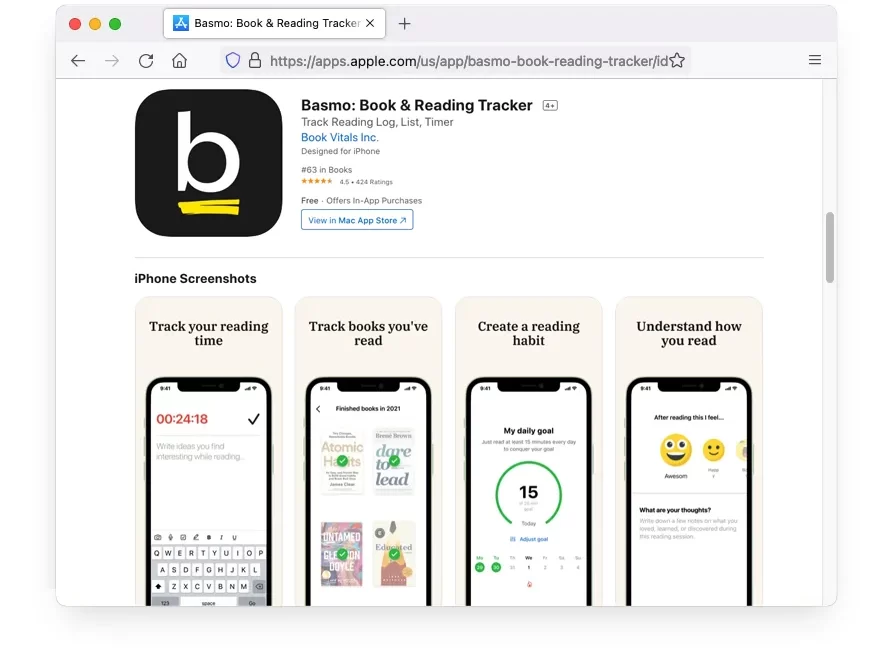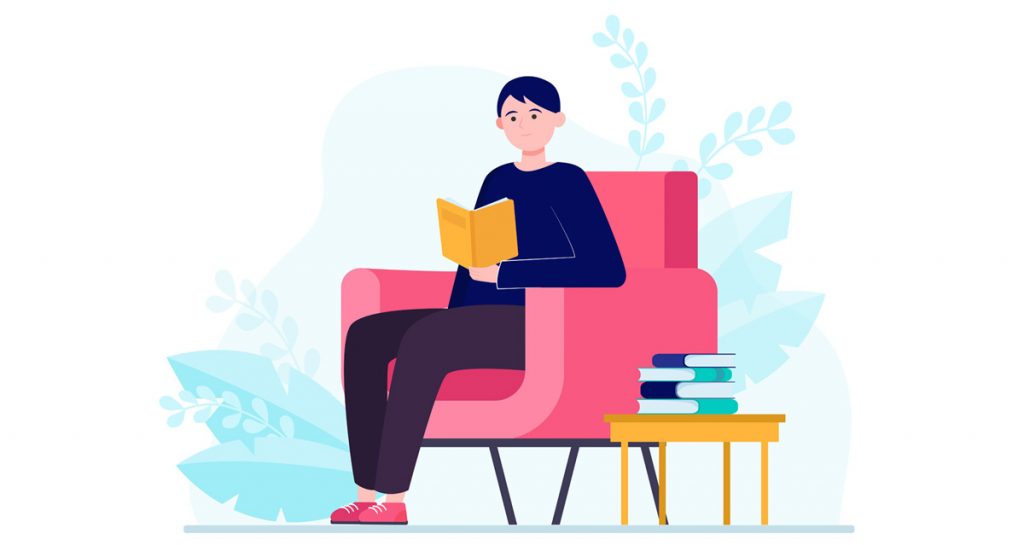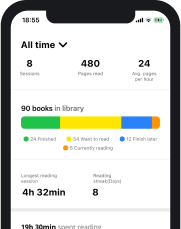While most of us don’t give it much thought, the truth is that reading, even though it is second nature to most of us, is a complex activity that involves a wide series of processes and techniques. Reading can be done in a lot of different ways and each technique or strategy has its own list of benefits and drawbacks. Choosing the right technique in each scenario can make a huge difference regarding your efficiency and the final results of your reading session.
Here at Basmo, we are dedicated to helping you achieve the best possible results regardless of your goals. That being said, if you’re wondering what is passive reading and you’re curious to find out what you can achieve by choosing this technique, you’re definitely in the right place.
What is passive reading?
According to the official passive reading definition, passive reading can be described as the process of reading shallowly, without putting too much effort into the activity, focusing on the text and comprehension, and actually passing through the material mechanically.
The passive reader gains close to nothing from a reading session in terms of comprehension, clarity, connection, information retention, and visualization. There is no active exploration of the text involved and the passive reader pays little to no attention to any of the writing techniques or details in the text.
So, what does passive reading mean? It is actually the exact opposite of active reading, so the passive reading meaning can be explained as a superficial reading experience that has almost no impact on the reader’s intellect.
What are some passive reading examples?
While these can barely be called passive reading techniques or passive reading strategies, since the effect they have on the reading experience is generally not a positive one, you should still know how passive reading actually works. So, here are some examples for you.
1. Rushing into it
A rewarding reading session generally starts with some prep work and requires a little effort for the best results. Rushing into reading and doing it quickly just to get it done is usually a clear sign of passive reading. Reading with a speed that is too high to facilitate any comprehension or retention is a clear example of passive reading
2. Retaining no information
Another example of passive reading is a circumstance where the reader seems to forget everything they read as soon as they close the book. Not being able to remember any character names or at least some vague details about the action in the book indicates that the reader went through the book passively and read it with no intention of investing effort or attention in the process.
3. Falling asleep while reading
Reading before bed is usually a healthy habit. Falling asleep while reading, on the other hand, is a clear sign that you are not involved in the reading process to a good enough degree. Yes, reading is relaxing and a good way to finish a day. But if you fall asleep involuntarily while reading with the book on your chest, without putting it on the nightstand for example, it means that you weren’t engaging with the text and not paying attention to what you were reading.
4. Engaging in distracting activities while reading
Texting, emailing, or watching TV while reading are just a couple of examples of allowing distractions to interrupt your reading session. Again, there needs to be a clarification made. We all get distracted while reading at some point. Our phones ring, emails arrive in our inboxes and chat windows pop up on our screens. The differentiation is made by our intentions. An active reader will get annoyed by these distractions and will choose not to answer the phone or not engage in other activities while reading.
A passive reader will embrace the distractions or will even initiate actions that other readers would be annoyed by. Voluntarily looking at the TV or initiating a chat with someone while reading are clear signs of a passive reading session.
What are the benefits of passive reading?
Since reading is generally a mentally challenging activity with a ton of benefits, bypassing pretty much everything that makes it great is usually not a great idea. Reading passively is not exactly recommended, as it has very few benefits and quite a lot of drawbacks.
1. It can still be a relaxing way to pass the time
Even though the intellectual, comprehension, and retention-improving characteristics of reading are significantly limited when reading passively, you can still enjoy a relaxing experience. As we know, reading is a great stress-relief tool and even though you are missing out on quite a lot of the other benefits through passive reading, this activity is still going to help you unwind after a long day.
Granted, even the stress-relieving properties of reading are going to be reduced because the main way in which reading helps you destress is by creating a level of separation between and your day-to-day problems. It helps you disconnect and focus on an alternative reality for a while. If you are not focusing on the things you are reading, chances are that your mind is still going to wander and you won’t be as successful in relieving stress and anxiety as you would through an active reading session.
2. You can read faster
While most readers don’t actually give it much thought, our reading speed is a very important factor in determining our ultimate performance. Improving the reading speed is a great way of increasing the amount of reading we get to do on a daily basis. Of course, reading too quickly, to the point where comprehension and information retention are compromised, is not the best idea.
But if you manage to find a balance between improving reading speed, reading passively, and levels of comprehension, you can take advantage of a whole lot of benefits. Of course, the results will pale in comparison to what you can achieve during an active reading session, but your time is still better spent than it would be doing something else.
To keep track of your reading speed and be able to find the perfect balance, you can use Basmo. Our reading tracking app is an amazing little wizard that is going to completely revamp your reading habits and will boost your performance. It times every single reading session you go through, helping you count the pages you read in any specific time frame, thus calculating your reading speed. Moreover, it keeps track of certain reading KPIs, which is an amazingly powerful tool for improving your performance.

On top of this, Basmo can help you stay well-organized, regardless of whether you want to read passively or actively.
You can use the app to set a clear reading schedule. The scheduling assistant is highly customizable and allows you to easily work around your daily or weekly routine. You can select the days of the week and different times of day for your reading sessions, and the app will even remind you through notifications of your upcoming sessions.
With Basmo, you can create reading lists. I know, it sounds like something that wouldn’t matter too much to a passive reader, but the truth is that even if you are the kind of person who usually reads without putting much thought into the process, there are still books out there that will require a different approach. With Basmo, you can create as many reading lists as you want or need, and you can personalize them however you see fit. For example, you could keep separate lists for the books you can afford to read passively, like romance or breezy young adult novels, and the ones that require more effort and attention like non-fiction or classics.
Moreover, Basmo encourages you to set goals for your reading. You can select a daily goal for the number of minutes of reading you do every day or a yearly goal for the total number of books you go through within a year. Whether you want to do your reading actively, passively, or a mix between the two is up to you. The important thing to remember is that Basmo is your ultimate reading tool and will help you tremendously regardless of your ultimate goals.
Give Your Reading Experience
An Extra Boost With Basmo
Track the books you read, monitor the time you spend reading and keep notes on your reading habits and how it makes you feel. You can set yourself targets for the time you spend reading and you can get notified whenever you’re behind on your reading time.
3. It’s still healthier than other forms of entertainment
Yes, passive reading is not ideal, that’s for sure. But there is still a lot for you to gain even if you don’t put as much effort into your reading sessions as you would when reading actively.
You will still enjoy more physical and mental health benefits through passive reading than through other forms of entertainment like watching TV or spending time on your phone. Reading, regardless of how distracted you are or how passive your session is, still keeps you away from the blue light emitted by the screens in your home. This can help you sleep a lot better.
You will still use your imagination to a certain extent. Even if you are not paying too much attention to the things you are reading, you are still going to subconsciously create mental images of the things you are reading about. You may not notice too many details in the material, you may miss out on certain subtle aspects, you may not perfectly understand the themes and you may not necessarily appreciate the quality of the author’s work, but you are still going to be somewhat involved in the story.
What is the difference between active and passive reading?
As I mentioned, active and passive reading sit at opposite parts of the reading spectrum. Active reading is pretty much everything passive reading isn’t. Here are some of the main differences between the two techniques.
Passive reading means applying the same level of involvement at all times
While active readers carefully adjust their attention level and the necessity of thoroughly analyzing the text while reading depending on the difficulty of each section, passive reading is done with the same speed, implication, and attention at all times.
During a passive reading session, the reader doesn’t pay attention to how complicated the concepts are and makes little to no effort to carefully absorb the information. This leads to a constant reading speed and a superficial approach that suffers no change regardless of the type of reading material at hand.
Active reading goes beyond the actual act of reading
On the contrary, active reading is done with a clear intent to extract maximum value from the entire process. That starts with understanding why that particular material needs to be read, whether that is an assignment or a personal wish. Active readers know exactly what their ultimate goals are and focus their energy on achieving them.
Passive reading, on the other hand, is simply done as a way to pass the time. There is no questioning of the reasons involved and no intent of going beyond the act of reading.
Passive readers ask and answer no questions
While active reading implies asking questions, being inquisitive, and actively trying to make predictions, passive reading is a linear process that starts and ends with simply consuming the content. There is no questioning involved, the reader makes no effort to try and predict where the action is going and makes little to no effort to make connections.
Active readers actively monitor their comprehension levels
Reading actively is a learning process. Active readers constantly pay attention to what they actually understand from the reading material. Any unknown word and any new concept go through a mental filter and are accompanied by a desire to gain a deeper understanding. Passive reading is the exact opposite. A passive reader will not stop to try and understand new words or concepts.
Passive readers take no notes and don’t annotate or highlight the text
Passive reading is, for a lack of a better word, passive. That means there is no additional action involved in the process on the reader’s part. For example, active reading requires note-taking, annotating, and highlighting. The reader will jot down thoughts about the concepts and will make notes of the important information he goes through to improve the chances of retaining the information.
None of that is actually involved in a passive reading session. And it’s a shame because Basmo can offer a lot of support in the whole process of taking notes, highlighting, or annotating books while reading.
Final thoughts
What is passive reading? It is a superficial form of reading that massively diminishes the reader’s benefits and the value of a reading session. While there are some instances when passive reading can be somewhat beneficial, Basmo can help you actually become a much better-performing reader.
Image by Freepik







